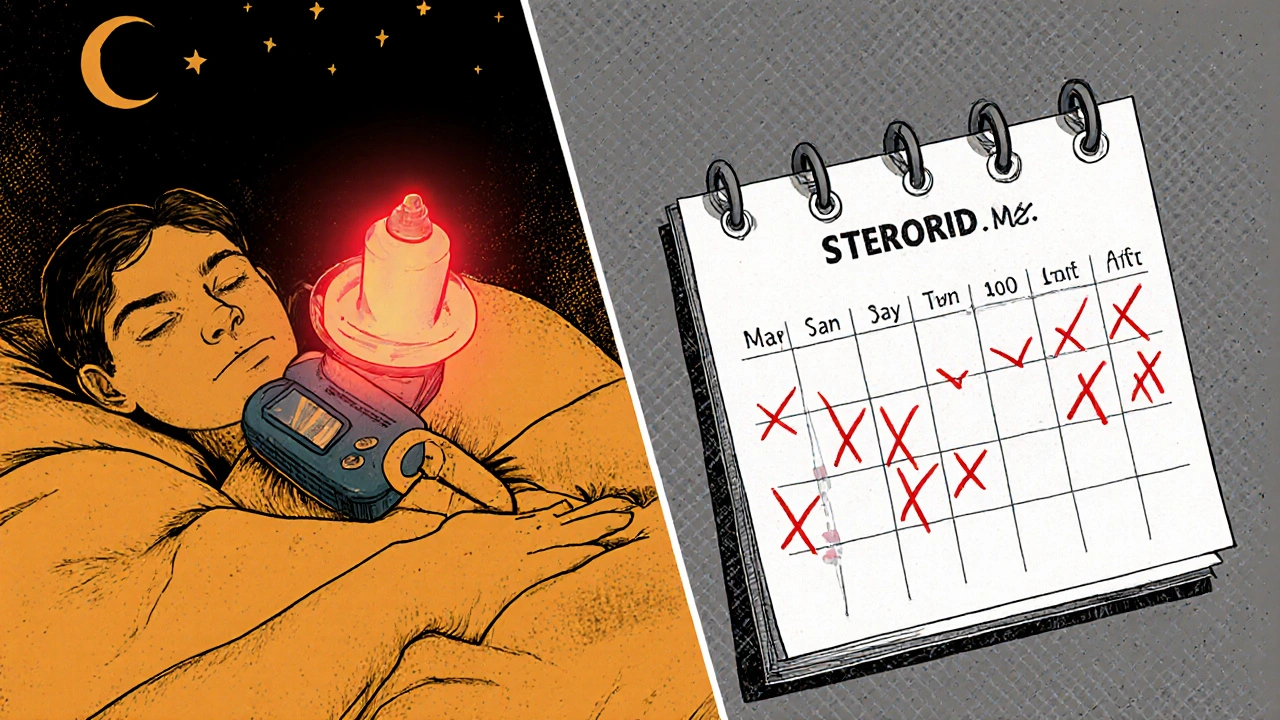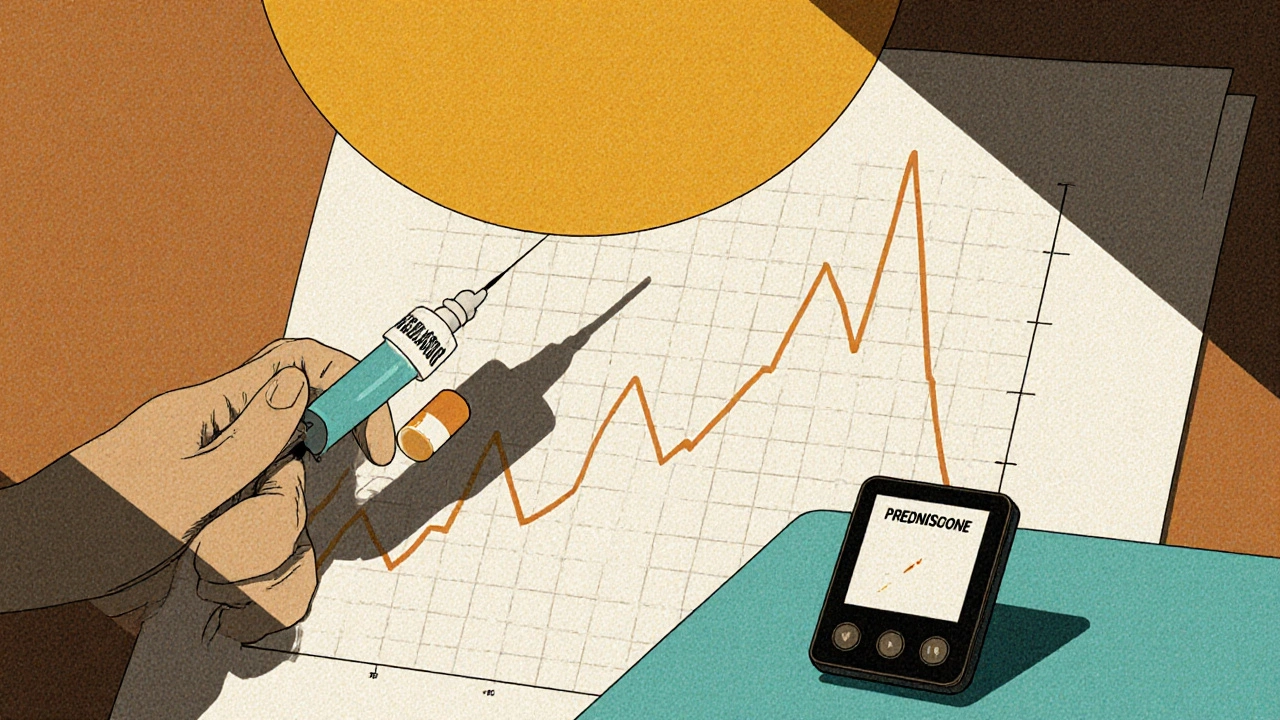Steroid-Adjusted Insulin Calculator
Personalized Insulin Adjustment Tool
This tool helps calculate appropriate insulin adjustments for steroid-induced hyperglycemia. Always consult with your healthcare provider before making changes to your medication regimen.
Recommended Insulin Adjustments
Start insulin adjustment when you begin steroid therapy. For prednisone, use NPH insulin in the morning. For dexamethasone, switch to long-acting analogs like glargine or detemir. Monitor blood sugar every 2-4 hours during peak steroid effect.
When you start taking steroids like prednisone or dexamethasone, your blood sugar can spike-even if you’ve never had diabetes before. This isn’t a fluke. It’s called steroid-induced hyperglycemia, and it happens in 20% to 50% of people on moderate to high doses. For those already living with diabetes, the spike can be even worse. The problem? Most people don’t expect it. And when it hits, they’re left guessing how much extra insulin to take-or worse, they don’t adjust at all.
Why Steroids Raise Blood Sugar
Steroids don’t just reduce inflammation. They also mess with how your body uses insulin. They make your liver pump out more glucose, block insulin from doing its job in muscles and fat, and even dull the signal from your pancreas to release insulin. The result? Blood sugar climbs, often within 4 to 8 hours after taking a steroid dose. It peaks around 24 hours later and can stay high for days after you stop, especially with longer-acting steroids like dexamethasone.Think of it like this: your body is running on a high-sugar setting. Even if you eat the same meals, your blood sugar will climb higher than usual. That’s why simply eating less won’t fix it. You need to adjust your diabetes meds-specifically insulin-to match the steroid’s rhythm.
Insulin Is the First-Line Tool
For most patients, especially those in hospital or on high-dose steroids, insulin is the go-to treatment. Oral medications like metformin or DPP-4 inhibitors might help in mild cases, but they’re not reliable enough when steroid levels are high. Insulin works fast, is predictable, and can be fine-tuned.The standard starting point? Give 0.1 unit of insulin per kilogram of body weight. So if you weigh 70 kg, that’s about 7 units total, split between basal (background) and bolus (meal) insulin. But here’s the catch: timing matters more than the number.
If you’re taking prednisone once a day in the morning, your blood sugar will peak around midday to evening. That means your rapid-acting insulin should be timed to match-not just given at meals. Many people make the mistake of only bolusing for food. But with steroids, you need insulin even if you’re not eating. A correction dose of 0.04 units per kg is recommended if your pre-meal glucose is between 11.1 and 16.7 mmol/L (200-300 mg/dL). If it’s higher than 16.7 mmol/L, use 0.08 units per kg.
Match the Insulin to the Steroid
Not all steroids are the same. And not all insulins work the same way. The key is matching the insulin’s duration to the steroid’s half-life.- Prednisone lasts 18-36 hours. Use NPH insulin in the morning-it peaks around 4-12 hours and lasts up to 18 hours, syncing well with prednisone’s effect.
- Dexamethasone lasts 36-72 hours. Use long-acting analogs like glargine or detemir. NPH won’t last long enough, and you’ll get spikes later in the day.
For example, if you’re on 40 mg of prednisone and normally take 30 units of basal insulin, you might need to add 10-15 units of NPH in the morning. But if you switch to dexamethasone, you’ll need to switch your basal insulin to glargine and increase it by 20-30%.
One real-world tip: if you’ve taken dexamethasone before and needed 20 extra units of insulin, don’t start with 20 again. Start with 10. Titrate up slowly. Steroid effects vary between people-and even between courses.

Monitor Like Your Life Depends on It
You can’t adjust insulin blind. You need data. Capillary blood glucose checks at least four times a day-before meals and at bedtime-are the bare minimum. But if you’re on high-dose steroids or your levels are swinging, check every 2-4 hours.Continuous glucose monitors (CGMs) are game-changers. They show you trends, not just snapshots. The goal? Stay in range-between 3.9 and 10.0 mmol/L (70-180 mg/dL)-at least 70% of the time. And keep time below 3.9 mmol/L under 4%. That’s the new standard from the Joint British Diabetes Societies.
One patient in Brisbane, on a 10-day prednisone course for a flare-up, used her CGM and noticed her glucose jumped at 3 a.m.-even though she hadn’t eaten. That’s the steroid’s delayed effect. She adjusted her basal insulin and avoided a hypoglycemic crash later.
The Biggest Mistake: Not Tapering Insulin with Steroids
Here’s where most people get hurt. When the steroid dose goes down, your blood sugar should drop. But if you keep the same insulin dose? You’re setting yourself up for low blood sugar.Studies show 30-40% of patients on steroids develop dangerous hypoglycemia during tapering because their insulin wasn’t reduced. One man on Reddit shared: “On 40 mg prednisone, I needed 50% more insulin. When I dropped to 20 mg, my doctor didn’t cut my insulin fast enough. I had three hypos in two days.”
That’s why guidelines say: reduce insulin as you reduce steroids. Start cutting insulin 3-4 days after you lower the steroid dose. For every 5 mg drop in prednisone, consider reducing basal insulin by 10-15%. For bolus insulin, cut back as your pre-meal numbers start falling below 10 mmol/L.
And watch out for sulfonylureas. These older diabetes pills force your pancreas to keep releasing insulin-even when your blood sugar is dropping. During steroid tapering, that can cause severe, delayed hypos. A Johns Hopkins study found 27% of patients on sulfonylureas during steroid therapy ended up in the ER for low blood sugar. Switch to insulin if you’re on these drugs.
Special Cases: Type 1 vs. Type 2 Diabetes
Type 1 diabetes patients usually need bigger insulin increases-30-50%-because they have zero insulin production. Type 2 patients often need 20-30% more, depending on how much insulin resistance they already have.Insulin pumps? They’re useful but tricky. You can increase your basal rate by 25-50% during peak steroid effect. But when you taper, you must reduce it just as carefully. A 2022 study found pump users who didn’t adjust their basal rates after steroid reduction had hypoglycemia within 48 hours.

What About Non-Insulin Drugs?
In outpatient settings with mild hyperglycemia (fasting glucose under 11.1 mmol/L), metformin, GLP-1 agonists, or DPP-4 inhibitors can help. But they’re not reliable during hospitalization or with high steroid doses. GLP-1 drugs like semaglutide can be useful for long-term control after steroids end, but they won’t stop the immediate spike.Thiazolidinediones (like pioglitazone) improve insulin sensitivity but take weeks to work. Too slow for steroid-induced spikes. Stick with insulin during active steroid use.
What Hospitals Are Doing Right
Hospitals that use standardized protocols see better outcomes. In 2023, 68% of U.S. hospitals had formal SIHG protocols-up from 42% in 2019. The best ones include:- Automatic insulin dose suggestions based on steroid type and dose
- CGM alerts tied to electronic health records
- Clear guidelines for reducing insulin during tapering
- Education for nurses and doctors on timing
At Massachusetts General Hospital, a quality improvement study found that 37% of errors were caused by not reducing insulin during tapering. Once they added automated alerts in the EHR, those errors dropped by 60%.
Final Takeaway: Anticipate, Match, Reduce
Steroid-induced hyperglycemia isn’t rare. It’s predictable. And it’s manageable-if you act early.Here’s your simple checklist:
- Start insulin before or at the same time as your first steroid dose.
- Match the insulin type to the steroid’s half-life (NPH for prednisone, glargine for dexamethasone).
- Monitor glucose every 2-4 hours during high-dose therapy.
- Use correction doses for high numbers-don’t wait for meals.
- Reduce insulin 3-4 days after lowering your steroid dose.
- Avoid sulfonylureas during steroid therapy.
- Use CGM if you can-it’s the best tool to avoid highs and lows.
Don’t wait for a crisis. Talk to your doctor or diabetes educator before starting steroids. Bring this guide. Ask: “What insulin plan should I start with? When do I reduce it?” Most people don’t ask-and end up in the hospital for something that could’ve been avoided.
Can steroid-induced hyperglycemia turn into type 2 diabetes?
Steroid-induced hyperglycemia doesn’t cause type 2 diabetes, but it can reveal underlying insulin resistance. If your blood sugar stays high after stopping steroids, you may have prediabetes or early type 2 diabetes. A follow-up HbA1c test 3 months after stopping steroids is recommended to check.
How long does steroid-induced high blood sugar last?
It depends on the steroid. Prednisone’s effect fades 3-4 days after the last dose. Dexamethasone can linger for up to a week. Blood sugar usually returns to baseline within 7-10 days after stopping, but insulin doses need to be reduced gradually during that time to avoid lows.
Should I stop taking my diabetes meds if I’m on steroids?
Never stop your meds without medical advice. But you likely need to adjust them. Oral meds like metformin may still be safe, but sulfonylureas should be paused. Insulin usually needs to be increased during steroid use and reduced during tapering. Always work with your healthcare team.
Is it safe to use an insulin pump during steroid therapy?
Yes, but carefully. Increase your basal rate by 25-50% during peak steroid effect. Use temporary basal rates if your pump allows. Monitor closely during tapering-reducing the basal rate too slowly can cause hypoglycemia. Talk to your diabetes team before starting.
What’s the best way to track my blood sugar on steroids?
Use a continuous glucose monitor (CGM) if possible. It shows trends and alerts you to highs and lows. If you don’t have one, check your blood sugar at least four times daily: before meals and at bedtime. More frequent checks (every 2-4 hours) are needed during dose changes or if your sugar is above 16.7 mmol/L.
Can I manage steroid-induced hyperglycemia with diet alone?
No. Diet helps, but steroids override food’s effect on blood sugar. Even a low-carb meal won’t stop a spike caused by prednisone or dexamethasone. Medication adjustment-especially insulin-is necessary. Don’t rely on food changes alone.
If you’re about to start steroids, don’t wait for your blood sugar to climb. Talk to your doctor now. Ask for a personalized insulin plan. Bring this information. You’re not overreacting-you’re being smart.






Shirou Spade
November 25, 2025 AT 08:52Steroids and blood sugar-it’s like your body’s thermostat got hacked by a pharmaceutical glitch. You didn’t ask for this, but now you’re stuck playing whack-a-mole with insulin doses. I’ve seen people crash because they thought, ‘I’ll just eat less.’ Nope. The steroid’s running the show now. You gotta match the drug’s rhythm, not fight it. It’s not about willpower. It’s about pharmacokinetics.
Lisa Odence
November 25, 2025 AT 19:27As a board-certified endocrinologist with over 22 years of clinical experience in metabolic disorders, I must emphasize that the clinical guidelines referenced herein are not only evidence-based but also align with the 2023 American Diabetes Association Standards of Medical Care in Diabetes, which explicitly recommend insulin as the first-line pharmacologic intervention for steroid-induced hyperglycemia, particularly in inpatient settings where glycemic variability is highest and risk of complications-including diabetic ketoacidosis and hyperosmolar hyperglycemic state-is significantly elevated. Moreover, the use of NPH insulin for prednisone and long-acting analogs for dexamethasone is not merely a suggestion-it is a standard of care supported by randomized controlled trials and meta-analyses published in The Lancet Diabetes & Endocrinology and JAMA Internal Medicine. Failure to adhere to these protocols constitutes a deviation from accepted medical practice and may expose clinicians to liability. Please consult your endocrinologist before making any adjustments.